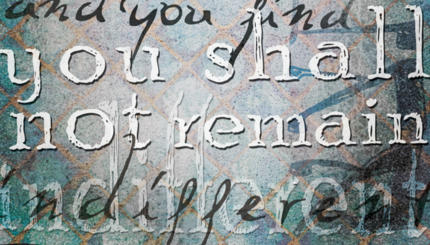Reprinted with permission from
The Torah: A Women’s Commentary
, edited by Tamara Cohn Eskenazi and Andrea L. Weiss (New York: URJ Press and Women of Reform Judaism, 2008).
The ancient Babylonian myth (or foundational story) that strongly resembles Genesis I has one great dissimilarity from it: in that myth, creation begins with a murder. The goddess Tiamat–cognate to our word t’hom (watery chaos, 1:2)–is slain by the hero-god Marduk; and the universe is carved out of her body. Violence there is inextricable from the process of creation. In Genesis 1, however, creation entails no destruction. Even the primal watery abyss is not completely obliterated but lingers at the bottom of the sea to reappear in many a psalm or story. The drawing of distinctions and boundaries that marks both accounts is in Genesis I peaceful and harmonious.
In Genesis 1, however, creation entails no destruction. Even the primal watery abyss is not completely obliterated but lingers at the bottom of the sea to reappear in many a psalm or story. The drawing of distinctions and boundaries that marks both accounts is in Genesis I peaceful and harmonious.
God distinguishes elements of the original watery chaos by drawing boundaries between them and naming them: light and darkness, day and night. Created elements are not simple oppositions. They are both distinct and akin. Juxtaposed verses emphasize the parallels between elements. There are waters above and waters below. Between them stretch a solid expanse of earth and a solid expanse of firmament. The earth brings forth grasses and trees. The sky is strewn with lights. The sea and the air  bring forth swarms of living things, schools of fish, flocks of birds, clouds of insects. The earth births its many creatures, joyously productive, mirroring the water and the air. The creation of humankind continues these dual themes of distinction and similarity. Not one but two words underline the likeness between adam (the earthling) and its Maker. Humankind bears the tzelem (image) and d’mut (resemblance) of the divine Creator, although in contrast to God’s oneness, they are several. They are also distinguished from one another: zahar (which means “male” but is also a word related to “remember”), the bearer of the male member, and n’kevah (which means “female” but is also a word related to “piercing”), the pierced one. In Genesis 3 the two will become a hierarchy, but in Genesis 1, they are presented as equals. Both bear the divine image and semblance, both are adjured to “be fruitful and multiply, fill the earth and tame it, and hold sway … over all the earth” (1:28).
bring forth swarms of living things, schools of fish, flocks of birds, clouds of insects. The earth births its many creatures, joyously productive, mirroring the water and the air. The creation of humankind continues these dual themes of distinction and similarity. Not one but two words underline the likeness between adam (the earthling) and its Maker. Humankind bears the tzelem (image) and d’mut (resemblance) of the divine Creator, although in contrast to God’s oneness, they are several. They are also distinguished from one another: zahar (which means “male” but is also a word related to “remember”), the bearer of the male member, and n’kevah (which means “female” but is also a word related to “piercing”), the pierced one. In Genesis 3 the two will become a hierarchy, but in Genesis 1, they are presented as equals. Both bear the divine image and semblance, both are adjured to “be fruitful and multiply, fill the earth and tame it, and hold sway … over all the earth” (1:28).
Adam is the only creature whose sexuality the text notes–that is, describes as male and female. This suggests a sexuality unlike that of the animals. Moreover in both 1:27 and a summary in 5:1-3, the mention of adam‘s maleness and femaleness is immediately followed by the proclamation of its divine image, as if our diverse sexualities and our kinship with God were linked. Rather than our sexualities being dissimilar to God or excluded from the divine image, they seem to point toward some element in the divine nature, some divine attribute–creativity or delight, perhaps, or the longing for an Other–for which our embodied sexuality is the metaphor.
With your help, My Jewish Learning can provide endless opportunities for learning, connection and discovery.
Genesis 2 and 3 tell a darker tale. Here we learn why Adam is called adam. Multiple puns are evoked by the name: kinship with adamah (earth or soil) out of which adam is fashioned, association with the color red (adom) like the ruddy sunburnt skin of the worker and the red earth he was created to till, and resonance with blood (dam), the red life-fluid. Unlike in Genesis 1, however, in 2:7-3:20 the term adam refers to the man. The woman is never called adam but only ishah (woman), “for this one is taken from man” (2:23). Together they are ha-adam v’ishto, “the human and his woman,” for the first man represents both the male particular and the generically human.
As the verb “built” (2:22) attests, the creation of woman differs from other creations. The dual adam of Genesis 1 is created (bara) by divine word, and the adam of Genesis 2 is fashioned or molded (yatzar) by a divine potter. The woman is constructed (barah) out of part of an existing creation. An afterthought, created when adam finds the animals unsatisfactory for mating, she is meant to be ezer k’negdo, literally “a helper over against him,” that is, opposite him or corresponding to him. The  ambiguity in the expression foreshadows an ambivalent relationship. Is she against him or for him? A challenger or an “other” who mirrors him and merges with him? Awakening, adam claims her as part of himself: “bone of my bone, flesh of my flesh” (2:23). He does not appear to recognize her otherness, nor does he address her. Her only recorded conversations are first with the snake, then with God. Finally, at the end of the chapter, adam names her as he previously named the animals. It does not occur to him to ask her what she calls herself.
ambiguity in the expression foreshadows an ambivalent relationship. Is she against him or for him? A challenger or an “other” who mirrors him and merges with him? Awakening, adam claims her as part of himself: “bone of my bone, flesh of my flesh” (2:23). He does not appear to recognize her otherness, nor does he address her. Her only recorded conversations are first with the snake, then with God. Finally, at the end of the chapter, adam names her as he previously named the animals. It does not occur to him to ask her what she calls herself.
Genesis 1 is an account of the Creation, whereas Genesis 2-3 is an account of the creation of patriarchy–a remarkably truthful account. The world brought about by Genesis 2-3 is one in which desire is no longer joyful but oppressive. Even before the disobedience, relations between man and woman and world are commodified and function-based. Adam is created to till the soil. Woman is created to help Adam.
However lush, the garden is a workplace. Created things are good, not intrinsically as in Genesis 1, but because they are resources. The Garden is described as prime real estate, rich in water and in trees, and adjacent to lands rich in gold and gemstones. Everything is viewed extractively. The forbidden fruit is presented as the epitome of desire in terms not of intrinsic value but of what it is good for: “good to eat,” “alluring to the eyes,” “desirable for insight” (3:6).
Woman’s desire for man ensures her subjugation and her anguish (3:16). Man’s desire is nor even mentioned. He is exhausted by the effort to pull from the ground what can be consumed before descending into the ground and being consumed by it. Adam and Eve are alienated from each other, from the earth, from their labors, from the rest of creation.
The world of patriarchy cries out for mending. A mending world would commit itself to equality and power-sharing, to working cooperatively in order to fill needs and solve problems. At one again with rest of Creation, perhaps we would even learn not resent our mortality so bitterly. Reunited also rest of creation, men and women could learn again to be “loving friends”–as the traditional rabbinic wedding blessing portrays them.
The product of fourteen years of work and the contributions of more than 100 scholars, theologians, poets, and rabbis–all of them women–The Torah: A Women’s Commentary is a landmark achievement in biblical scholarship and an essential resource for the study of the Bible. For more information or to order a copy, visit URJBooksandMusic.com.


